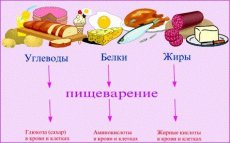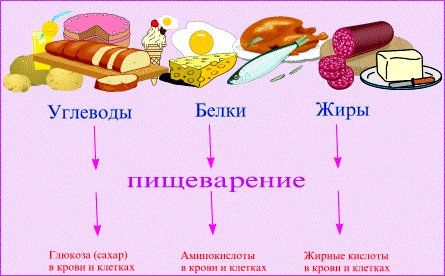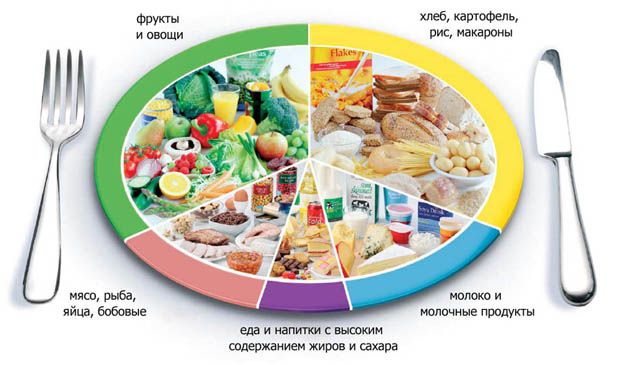Medical expert of the article
New publications
The main components of a meal
Last reviewed: 06.07.2025

All iLive content is medically reviewed or fact checked to ensure as much factual accuracy as possible.
We have strict sourcing guidelines and only link to reputable media sites, academic research institutions and, whenever possible, medically peer reviewed studies. Note that the numbers in parentheses ([1], [2], etc.) are clickable links to these studies.
If you feel that any of our content is inaccurate, out-of-date, or otherwise questionable, please select it and press Ctrl + Enter.

Our menu is our universal soldier, which supplies the body with all the necessary substances. Thanks to the chemical elements from food, we get energy and can spend it on studying, working, sports and personal life. And even on great discoveries. What is included in the composition of food? What are the main components of food and how do they affect our health?

Three pillars of healthy eating
These are fats, proteins, amino acids, which are important building materials for the cells of our body. They also contain trace elements and electrolytes so that reactions in our body proceed correctly. Vitamins help many processes in the body to proceed more actively or, on the contrary, inhibit them.
Metabolism is the holy of holies for the proper development of the body, the key that can open any reaction. When complex chemical reactions occur in the body due to the intake of food, a person receives an influx of energy and uses it as he pleases. These complex reactions trigger the metabolism in the body. Metabolism in the body occurs even when a person is sleeping, and regardless of his will.
There are seven components that help a person get proper nutrition and feel full. These are vitamins, minerals, fats, carbohydrates, proteins and amino acids, as well as water and fiber. Food contains all seven components, but the most common ones are usually only three. These are traditional fats, carbohydrates and proteins. They are measured as units of energy that a person gets from food. If you choose the wrong ratio of fats, carbohydrates and proteins or eat one while giving up the other in order to lose weight, this leads to improper metabolism and failure of many body functions.
Squirrels
The most serious disturbances in the body occur during protein deficiency.
Proteins are the building blocks of the body. Proteins are made up of amino acids, nine of which are not synthesized in the human body and must be absorbed from food. The content of essential amino acids in animal food is much higher than in plants. In addition, proteins from plant foods may not be completely metabolized in the body, about 65%, while animal proteins are 90%.
Protein standards
A person should consume 1 gram of protein per kilogram of body weight daily in a normal lifestyle. This minimum should be increased to 2 grams on days of sports training or other heavy physical activity. If you need to quickly increase muscle mass, you can use protein shakes to help your body develop.
Details about types of proteins
Proteins make up 50 percent of your body weight. These are muscles, organs, hair, nails, and skin. As your body replenishes cells, so your body needs new sources of protein. This process requires proteins, or the body will not grow.
Animal meats such as beef, pork, lamb, poultry and fish provide humans with complete proteins comparable to those in the body. Animal products such as dairy products and eggs have the same composition.
Plant proteins are considered incomplete proteins because they lack some of the amino acids that make up complete proteins. However, by combining plants and grains in your diet, you can consume complete proteins.
Complete proteins
Some food combinations that include complete proteins are all types of beans, brown rice, whole grain breads, whole grains, pasta. Soybeans have the same protein formula as meat and can be obtained from plants in many forms, such as tofu, lemongrass, or roasted soy nuts.
Fats

We must consume a certain amount of it. Fats perform energy-saving functions and are used to produce testosterone in the body.
Some fatty acids are necessary for the body and must be supplied with food. A LACK of fats leads to increased protein degradation, it also affects digestion, skin health, vascular fragility and can lead to hormonal imbalances.
Excess fat significantly increases the load on the cardiovascular system, can disrupt metabolism, and increases the likelihood of heart attack, stroke, and diabetes.
Types of fats
Saturated animal fats enter our body on a regular basis from foods such as meat and can be stored in reserve. At the same time, unsaturated fats are not stored in the body, but they are more necessary for it.
Unsaturated fats are important for replenishing essential acids such as linoleic, linolenic, etc. In principle, they can be taken from plant products (vegetable oil, nuts). Unsaturated fats are easy to identify - they remain liquid at room temperature.
Your body needs fats to manage digestion. The density of fats results in the absorption of more calories than carbohydrates and proteins. High-fat diets lead to obesity and increase cholesterol levels in the body. Eating fats gives you the feeling of fullness needed to avoid overeating.
Some fats are better for us than others. The bad, saturated fats we get from beef, butter, cheese, coconut oil, and palm oil.
The best fats for us are unsaturated fats, they are present in most vegetable oils - the best fats come from olives, almonds, canola and olive oils. This contributes to a healthy heart and blood vessels, because it entails a decrease in cholesterol. Some other healthy fats, Omega-3 and 6 fatty acids, not only prevent the increase in cholesterol, but can also reduce high cholesterol. You will find these fatty acids in the meat of fish such as tuna, herring, salmon, sardines and flaxseed oil or in pharmacy capsules.
Carbohydrates
Carbohydrates are our best source of energy, but proteins and fats can also be converted for these purposes. Carbohydrates can be simple and consist of one sugar molecule, or – less commonly – two molecules, and polysaccharides (such as starch). The polysaccharides are the most useful. The fiber in carbohydrate-containing fruits and vegetables is also beneficial to health.
Not enough carbohydrates can lead to low protein levels. Too many carbohydrates are also bad, as they cause carbohydrates to be converted into fat.
The best simple carbohydrates can be found in fruits and honey. Complex carbohydrates are found in large quantities in potatoes, bread (preferably from coarse flour). If you need to gain weight quickly, use protein-carbohydrate dishes.
With the exception of water, almost everything we eat and drink consists of carbohydrates, fats, or proteins. These basic elements make up diets in varying proportions. Despite a number of diets that aim to speed up the weight loss process by eating one of these elements to the exclusion of others, in a healthy diet we need all three components. Carbohydrates, fats, and proteins – each of them makes a significant contribution to the physical development of the body.
Details about carbohydrates
The culprit of obesity and diabetes, carbohydrates have been touted since their introduction in the Atkins diet. However, they contain vitamins, minerals, and fiber. Because carbohydrates contain starch compounds, they are easily converted into energy for the body's cells. Without this energy, you cannot breathe, move, pump muscles, or activate blood circulation.
Simple carbohydrates are converted into sugar faster than complex carbohydrates. This undesirable feature of simple carbohydrates causes a burden on the pancreas, the body produces enough insulin to escort this sugar into the body's cells at the same time.
Simple carbohydrates include white bread and pasta, white rice, and sweet desserts. Complex carbohydrates, such as whole grain bread, pasta, and flour, in turn, allow the body to absorb glucose in a short period of time.
Amino acids
All proteins in the body are made from compounds called amino acids. There are twenty amino acids in numerous combinations to create the 50,000 types of proteins needed to build every cell in our body. Nine amino acids can only be obtained from food, but our body will be able to create the others.
Daily protein requirements
When we take protein from food, our body breaks it down into its component amino acids. The body then uses these amino acids to create the protein needed to build cells, tissues, organs, hormones, neurotransmitters, and enzymes—in other words, everything that makes up our bodies. Protein intake should make up between 10 and 35 percent of our daily calories.
Children aged 1 to 3 years should consume 13 grams of protein per day, while children aged 4 to 8 should consume 19 grams of protein. Due to growth spurts and maturation during adolescence and young adulthood, this amount nearly doubles to 34 grams between ages 9 and 13, then increases to 46 grams for girls and 52 grams for boys through age 18. Protein levels decline in adulthood to 46 grams for women and 56 grams for men.
Essential amino acids
The nine amino acids that our bodies cannot produce are histidine, isoleucine, leucine, lysine, methionine, phenylalanine, threonine, tryptophan, and valine. The 10 amino acids that are essential for very young people are arginine.
Replaceable amino acids
The remaining 10 amino acids are divided into two categories, conventionally called essential. The four nonessential amino acids are alanine, asparagine, aspartic acid, and glutamic acid. The term "essential" does not mean that you don't need them, only that your body can make them when you don't eat them.
Conditional amino acids
Conditional amino acids are cysteine, glutamine, tyrosine, glycine, ornithine, proline, serine. You need them during periods of stress or illness. Your body creates conditional amino acids as long as there is a need for them. For example, the conditional amino acid tyrosine is made up of the essential amino acid phenylalanine, highlighting the importance of including essential amino acids in your diet.
Food sources of amino acids
Protein (and the amino acids it contains) is found in meat, poultry, fish, legumes, eggs, dairy products, soy products, nuts, seeds, grains, and vegetables. Protein is classified as complete or incomplete based on whether it contains essential amino acids.
Complete proteins contain all the essential amino acids and are found in foods from animal sources, as well as soy. Incomplete proteins are found only in foods from plant sources. However, foods from different plant sources contain large amounts of some amino acids, but not others. That is, the amino acid content of proteins is not the same for all foods. By combining these additional proteins, you can get all the essential amino acids even on a vegetarian diet.
Vitamins
Vitamins are substances that our body needs to grow and develop normally. There are 13 vitamins that we need primarily. These are vitamins A, C, D, E, K and the B vitamins (thiamine, riboflavin, niacin, pantothenic acid, biotin, vitamin B-6, vitamin B-12 and folate). We can usually get all the vitamins from the foods we eat. Our body can also take vitamins D and K. People who prefer a vegetarian diet can take vitamin B12 as an additional source of energy.
Types of vitamins
Water-soluble vitamins are easily absorbed by the body, which does not store large quantities of them.
Fat-soluble vitamins are absorbed into the body using bile acids, which are liquids that are soluble only in fats. The body stores them for use when needed.
Each vitamin has a specific intake. If you are low in certain vitamins, you may develop diseases. For example, if you do not get enough vitamin D, you may develop rickets. Some vitamins can help prevent medical problems. Vitamin A is good for fighting skin diseases, as well as night blindness.
The best way to get enough vitamins is to eat a balanced diet with a variety of foods. In some cases, you may need to take a daily multivitamin to maintain your health. However, high doses of some vitamins can have the opposite effect.
Rules for taking vitamins
Principles of taking vitamins include the following:
- When taking vitamins, you need to choose foods that contain a minimum of saturated and trans fats, cholesterol, added sugar, salt and alcohol.
- It is advisable to take nutrients depending on the body's energy needs. Do not exceed the doses of vitamins - this will bring more harm to the body than good.
- If you are over 50, you definitely need vitamin B-12 in its crystalline form, which is found in fortified foods or supplements.
- If you are a woman of childbearing age who wants to become pregnant, eat foods high in iron and/or consume iron-rich plant foods or foods fortified with iron, such as foods high in vitamin C.
- If you are a woman of childbearing age who is in the first trimester of pregnancy, you need to get enough synthetic folate every day (from fortified foods or supplements) in addition to your other foods.
- If you are pale or have too light skin color, you may need to consume additional vitamin D through vitamin D-fortified foods and/or appropriate vitamin supplements.


 [
[